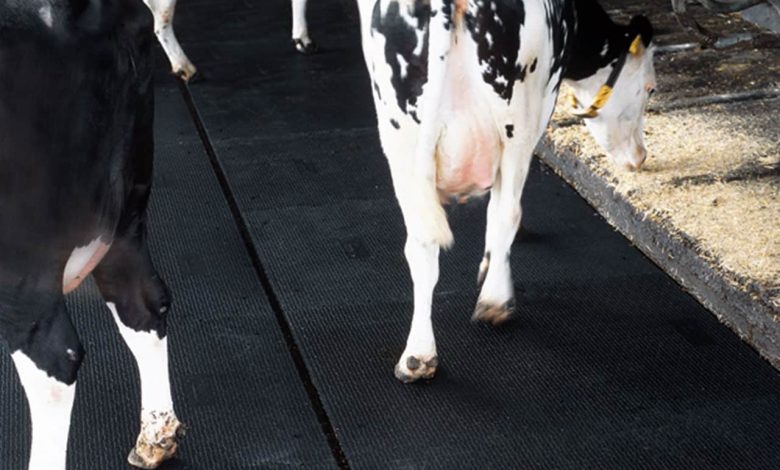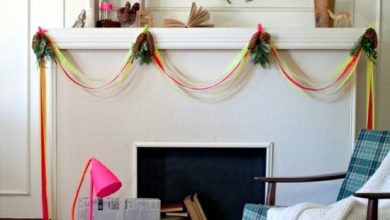Why Rubber Mats are Useful in Dairy Farms?

Rubber matting for cows has been shown in studies to improve movement, hoof and leg health. Rubber mats provide a softer underfoot environment than concrete flooring, which lessens physical trauma to the hoof and, as a result, lameness.
A cow’s hooves are designed to tread on soft terrain like grass, sand, and mud. This is not the case in today’s dairy farms, where cows spend hours walking to and from the milking shed on concrete floors and gravel pathways.
Why is rubber matting better than concrete?
In dairy farms, concrete is the most prevalent flooring material. Concrete flooring can be slick, especially on ramps and alleyways.
In a study comparing concrete floors to rubber flooring, researchers discovered that cows on concrete floors were more likely to be lame than those on rubber floors, necessitating more treatments. As a result, rubber matting can help you save money on animal health care.
Animals may prefer softer surfaces to stand, walk, and lie on, just as people like spending time on softer surfaces such as beds and sofas and walking in cushioned shoes.
Rubber matting improves grip for cows
The comfort and grip of alley flooring can be improved by rubber mats. Rubber floors are available in a variety of thicknesses and styles on the market today. To create a floor that reduces the risk of slipping, a rubber mat with a thickness of at least 10 mm is required.
Cows with or without sole ulcers walked more firmly, with longer and higher leaps, more symmetrical steps, and at a faster speed on rubber floors than on concrete floors, according to tests. This supports the assumption that walking on rubber floors is more comfortable and secure than walking on concrete floors.
Lameness in dairy cows and its causes
Cows become lame for a variety of causes. One theory is that modern cows spend a lot of time on hard, slick flooring, causing strain injuries in their outer rear hooves. This can result in sole lesions, which eventually contribute to lameness.
Sole hemorrhages were reported to be less common on rubber floors and more common on concrete floors in studies. A softer floor may reduce the danger of strain injuries, lowering the chance of sole hemorrhages.
A sole ulcer is a painful foot ailment that frequently causes lameness in horses. A sole ulcer is a canal through the diseased, hemorrhagic sole horn to the corium that usually occurs in the lateral hoof of the back feet. A single ulcer can be expensive to treat. Breeding, correct nutrition, hoof trimming, and softer flooring can all help to prevent sole ulcers.
Rubber dairy mats can also make hygiene easier to maintain because they feature a non-porous surface that is easy to clean. In a setting with rubber matting, lameness issues such as digital dermatitis can be more easily addressed since hygiene can be improved.
- Have you ever paid attention to cows as they move around on races and in the yards during milking? If they are walking more slowly in certain areas, it could indicate that they are slipping or that they are making the cows uncomfortable for some reason.
- Is everyone on your farm aware that cows with their heads up are under too much stress?
- Do you know when a cow is lame before they reach the back of the herd and can’t bear weight on their hoof?
- Is everyone on your farm aware of how to operate the backing gate to increase cow flow while reducing hoof damage in the yards?
- Do you have enough skilled people to treat lame cows and ensure that they are all cured as soon as possible?
To achieve sustainable dairy production with healthy, happy, and high-yielding cows, animal welfare must be considered.
Rubber matting has a high return on investment.
When a cow is sick, not only there is a direct expense for veterinary treatment and extra labor for farm personnel, but there are also indirect financial losses owing to lower yield. Milk production has been proven to drop for months before and after the start of a sickness or ailment like lameness.
Rubber matting has been shown in studies to lessen lameness and aid cows in recovering faster from disease or injury. As a result, rubber matting can assist in reducing the financial losses associated with lameness.
Some dairy solutions, such as gravel, have high maintenance costs. Rubber matting is long-lasting. As a result, rubber matting could help you save time and money when it comes to alley upkeep.
Highrange rubber mats provides pleasant walking spaces while also keeping your alleyways clean.
The natural rubber surface mimics the sensation of actual grass, putting the cows at comfortable right away and preventing lameness and falls.
Benefits of Installing Rubber Mats in Cow Sheds
Rubber mats have been shown to improve a cow’s mobility, health, hygiene, and behavior, not to mention milk output.
Rubber mats are also good for cattle handling because of the following features:
Surface that is non-slip
Rubber mats not only reduce the chance of slipping, but they also lengthen the stride and step length of a cow. Rubber mats are preferred by cows because they are similar to their natural habitat — grassy fields. Cows get more active as their daily steps increase longer and longer.
Provide support and cushioning
Rubber mats can help cows avoid foot and knee problems that might develop when they stand for lengthy periods of time on a hard surface. They can also absorb sounds from industry and animal movement.
Excellent Insulation
Rubber mats help prevent cows from rheumatism and tiredness by protecting them from the cold and dampness of the base flooring.
Hygienic
Rubber mats are non-porous and do not hold moisture, making them easy to clean and disinfect. They also have superior waste drainage, resulting in cleaner circumstances.
When a cow becomes unwell or injured, it will inevitably reduce milk supply, necessitate additional labor, and result in financial losses. Cows’ health, well-being, and general performance will be ensured through careful control of their living environment.
What Do Cow Mats Do?
Cow Rubber Mats are developed to help your dairy farm with a range of tasks. Our Cow Mats from Highrange will provide you with the following benefits:
- Milk supply has increased by 15% on a daily basis
- Cow knee injury is less common
- Anti-fatigue properties
- Increases the amount of time when cows aren’t laying eggs
- Lameness is reduced
- Cleaning is simple
- Bottom surface drain channel
- Affordable
- Weather insulation
- Blood supply is increased
- 2-year warranty
What Else Can Cow Rubber Mats Do?
Cow rubber mats are made to take you beyond the points discussed previously.
At Highrange, we recognize that cost incurring is a major worry for dairy farmers. You must continuously choose what is best for your budget.
You may save a lot of money on flooring maintenance for your cow sheds if you use Animal mats with channel drainage.
It lasts longer and makes cleaning your cow bedding area easier for you and your team. This allows you to focus more on business development rather than worrying about flooring management.
Also.
If your cows and livestock become lame, it’s likely that your revenues and sales will suffer as well.
None of this is desirable since it just makes it more difficult for you to create milk sales. Your livestock’s healthcare bills will rise.
Adding even more unneeded expenses to an overburdened budget.
This also means that using cow rubber mats will save you a lot of money on animal shed maintenance. As a result, it is one of the most cost-effective animal shed flooring on the market today.
What are the Benefits of Using Cow Mats?
Sand, straw, or brick concrete have traditionally been used as bedding or floor surfaces on most dairy farms.
For the past 7-8 years, Cow Mats have been used in India. Mats are made in a variety of qualities, from low grade to extremely durable.
Cow Mats are constructed of Microcellular Rubber, which works as a mattress and provides a pleasant bedding surface. This mattress-like behaviour is due to the key attribute of elastic re-bounce.
Cow Mats are comprised of a Closed Cell Structure, which is made up of millions of small air bubbles encased in a polymeric phase that does not absorb liquids and serves as a cushion.
Mats retain these features for a reasonable period of time while not in use, allowing them to serve as effective and long-lasting Dairy Cow bedding.
The rubber surface is skid-resistant, preventing cows from slipping on wet areas and allowing them to walk stress-free.
The load-bearing ability of Rubber mats is an important feature. Alternatively, it is the maximum weight a mat can support without losing its springy qualities over time.
Mats with channels help to drain excess water and keep the area dry. Cows prefer mats that contain a modest bit of straw or a blend of lime powder and wood flour.
Cheap mats contain no rubber, making them inferior to Rubber Cow Mats in terms of performance.
Mats are thought to be a wise investment because of the benefits of increased milk supply, reduced labour, and improved cow health.
Should I Purchase Cow Rubber Mats from the Internet?
When it comes to online Cow Mattress Prices, the idea is to always go with a reputable provider. A well-known organisation that will provide you with warranties.
It is also recommended that you, as a customer, have direct contact with the company prior to making a purchase.
While purchasing cow mats online, call them and speak with someone.
The Highrange Commitment
At Highrange, we believe in not just enhancing dairy farming processes, but also assisting dairy farmers with cow shed flooring guidance.
Our dedication to offering long-lasting, low-cost Animal mats has given us a household name.



